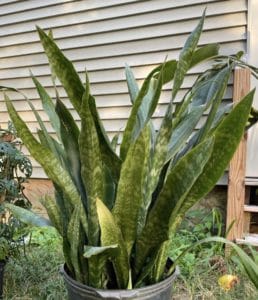Snake plants are striking, low-maintenance plants that add an exotic, edgy touch to any home or garden. Also known as mother-in-law’s tongue and sansevieria, they get their common name from their long, elaborately-patterned leaves, which resemble snakeskin. They’re also considered one of the easiest houseplants to care for, making them a perfect option for busy people or those new to caring for plants.
And while most people choose to keep their snake plants indoors because of their air-purifying qualities, others bring them outside during the warmer months. But can snake plants live outside in winter? The short answer is yes, but it should only be attempted if you live in a warm climate. If there’s any prolonged frost or snow, you’re better off bringing them inside.
Can Snake Plants Live Outside in Winter?
Unfortunately, snake plants are not suitable for most outdoor conditions in winter. They prefer warm, dry conditions and will not tolerate cold or overly wet weather. However, in USDA hardiness zones 9 to 11, you should be able to keep your snake plant outdoors without any problems.
If you overwinter your snake plant outdoors in cooler climates, expect to give them extra care. Snake plants can tolerate some temperature drops but need an average temperature of 55 F or warmer to thrive. They won’t survive being frozen solid. So if your area experiences mild winter conditions, you’ll need a solid plan to keep your snake plant warm.
Protecting Snake Plants From the Cold
If you keep your snake plant outdoors in winter, you can protect it from the cold by placing it in a sheltered spot. Of course, a sunroom or greenhouse would be ideal, but a porch or patio can also work, assuming it’s not too exposed to the elements or cold drafts. If you notice your plant’s leaves starting to curl or yellow, it’s a sure sign that they aren’t handling the cold well.
You can also cover your snake plant with a frost-proof cloth to help insulate it from the cold. These are readily available online, at most hardware stores and gardening centers, and can make a big difference in protecting your plant. Ensure the fabric is breathable (regular tarps won’t do), as snake plants can suffer from rot if kept too moist.
When To Bring Snake Plants Indoors
If you can’t provide your snake plant with the warm conditions it needs to survive outdoors, it’s better to bring it indoors for the winter. Aim to have it indoors before the first frost hits, as this can damage the leaves, leaving the plant more susceptible to disease.
When you bring your snake plant indoors, give it a good cleaning to remove any dirt or pests that may have hitchhiked their way inside. Inspect the leaves carefully and cut off any that are damaged or yellowing. These can be thrown away or tossed in the compost bin. Snake plants are tough and can withstand some abuse, but damaged leaves can provide entry points for pests and disease.
Once your snake plant is clean and healthy, find a spot for it inside where it will get bright, indirect light. A south-facing windowsill is ideal, but anywhere that gets good light but isn’t in direct sun will work. Snake plants can tolerate lower light conditions but keep them away from dark, dreary corners.
Parting Thoughts
Ultimately, whether or not you can keep your snake plant outdoors in winter will depend on the climate where you live. If you’re unsure whether your area is too cold, don’t take the chance. Bring your snake plant indoors where it’s warm and dry. It’s much easier to care for a snake plant indoors than trying to protect it from the cold outdoors. Your snake plant will thank you.


